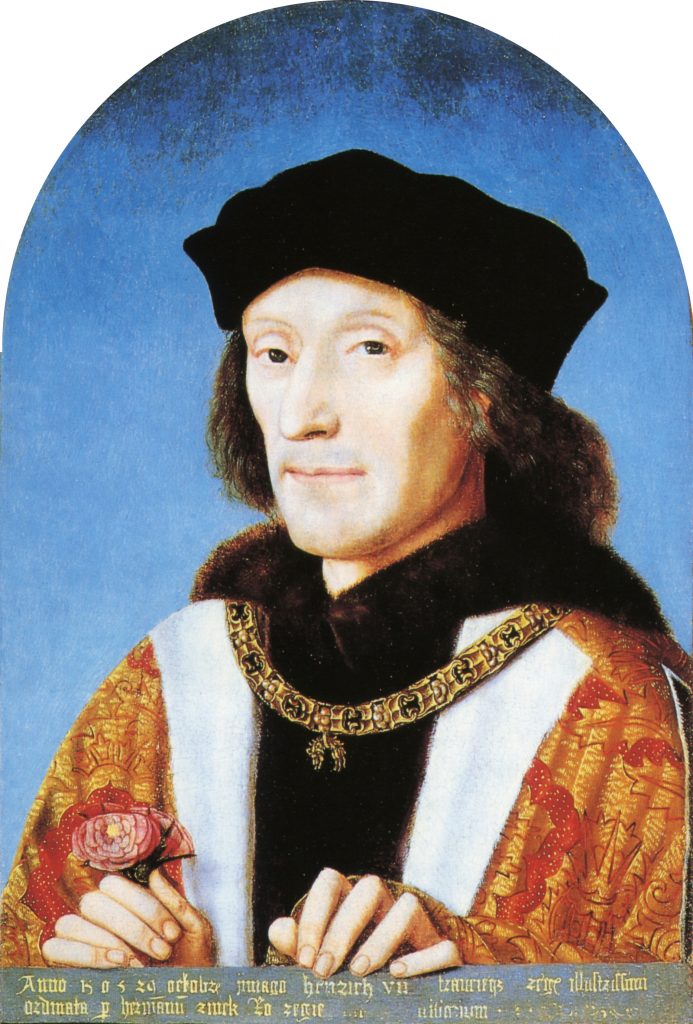“His spirit was distinguished, wise and prudent; his mind was brave and resolute and never, even at moments of the greatest danger, deserted him. In government he was shrewd and prudent, so that no one dared to get the better of him through deceit or guile. He was gracious and kind and was as attentive to his visitors as he was easy of access. But those of his subjects who were indebted to him and who did not pay him due honour or who were generous only with promises, he treated with harsh severity. He cherished justice above all things; as a result he vigorously punished violence, manslaughter and every other kind of wickedness whatsoever.”1
-Polydore Vergil, The Anglia Historia, 1485-1537
When the War of the Roses took place, and the Crown was threatened to be taken from the York family, the Tudor Dynasty rose to be the most powerful, but yet one of the shortest periods of time for a family to rule. It all began with the first Tudor king, Henry Tudor, who later became known as King Henry VII.2 After sailing across the English Channel from France, Henry Tudor traveled through southern Wales, into the Welsh countryside with roughly 2,000 men at his side. Through his charm and influence, his army had doubled in size by the time they crossed into Shrewsbury. However, this quiet invasion hadn’t gone unnoticed. King Richard III was alarmed at the sudden growth of his enemy’s army, and decided to gather his troops of 10,000 men at the city of Leicester on August 22, 1485. From there, he launched them into battle with the Lancaster army directly on the hill top of Market Bosworth. With both armies fully launched in battle, Richard sensed betrayal in his army, and took it upon himself to make the lethal mistake of interfering in the bloodshed. As the Lancaster army started to gain the upper hand in the fight, Henry Tudor’s step-father, Lord Thomas Stanley, who had privately pledged to betray the Yorkist army and take part in the Lancaster revolution, deployed his army of 6,000 men into battle. The betrayal came as a shock to the Yorkist men, seeing their comrades being killed by the hundreds, from the hands that they thought they could trust. This ultimately led to the demise of Richard’s army, leaving the king unprotected from Henry. The future Tudor king took this opportunity to brutally kill his enemy and announce himself as king on same ground where his enemies lay dead.3In the aftermath of the battle, England was in chaos, not knowing who to trust or what to believe. Henry worried that England wouldn’t accept him as its king, since he took the throne by force. He had doubts, constantly wondering whether he would actually be a great king. He often asked himself, “shall I win? But, how shall I proceed when I have won?” He knew he would have to take drastic measures in order to gain the trust of England, and with that came the decision to marry his enemy’s niece, Elizabeth of York. Such a marriage would unite both sides of the warring houses, and end the hostilities between the Yorkists and the Lancasters.4 People that worked in the royal household say that there was no scandal between the marriage of Elizabeth of York and Henry. If anything, he was completely loyal to her, and turned more affectionate towards her after the news that their eldest son, Prince Arthur,had died.5 This was a major factor in uniting the two families together.

Henry became popular among the people of England by making the government more trustworthy and efficient.6 King Henry had his reputation planned out ahead of him by many of his family members just before he became king. Many thought of him as, “a king who had no pleasures but preferred bookkeeping, who attended tournaments only to pass time writing memoranda, a husband whose relations with his wife was warped by hatred for her father’s house.” But he was able to prove many of these accusations incorrect. He had put in officials who had been previously on Edward IV’s counsel, the father of Elizabeth of York, and the king prior to Richard III, such as his first chancellor, Thomas Rotherham. Despite the fact that he was known to be favored by many for his tranquil personality, his real strength was portrayed through administering his government, for which he attended four to five issues daily and was constantly on the move, trying to restrain rebellions. He made public appearances every now and then to keep the trust of his citizens.7 Henry wasn’t moved by luxury or wasn’t considered holy by overcoming “human” grievances. He was ordinary in most people’s eyes, affected by the same moments of happiness, anger, and sadness as anyone else would have been.
He introduced “modern” bureaucratic methods to the government, which was able to save the monarch from financial crisis, and was able to strengthen trade.8 However, there were people, even on his counsel, that did not trust him. A movement was sparked by a Yorkist, Lambert Simnel, who was a son of an Oxford tradesman, who was believed to be one of the sons that was murdered by Richard III, the heir of Edward IV, and who was therefore the natural heir to the throne. This movement was supported by the King’s mother in law, Elizabeth Woodville, the former queen of England. Many other conspiracies were made against King Henry, but this was the most serious as it was related to his family, and more importantly, directly connected to his wife.9 This conspiracy started a large uprising in Ireland, where a nobleman, the Earl of Kildare, part of the Yorkist movement, believed that Lambert Simnel was the natural heir to the throne. Kildare was openly disloyal to Henry and launched his invasion on England to deal with Henry.10 King Henry, who was normally calm, was alarmed by this. Before this, he had felt that his position as king was secure after his first year as king; but as this threat grew and people started to believe that the impostor was the actual son of Edward IV, there was an unease in the royal house.11 This threat to the crown was demolished when King Henry VII was victorious in the Battle of Stoke on July 16, 1487.12 As many as 4,000 men were killed in the battle who had been followers of the Yorkist rebellion. Meanwhile, Simnel and his tutor were captured, and their lives were spared, with Simnel becoming a kitchen servant in the Royal palace, and his tutor, Simons, being confined to a bishop’s prison.

Many, including King Henry, thought that this was the end of the Yorkist movement, or at least that it was the end of the worst of it. Yet, a new conspiracy was launched by the French, but this plot was not condoned by the French king, King Charles. He even promised that he would expel any of those who supported this scheme. But the plot was fully accepted by a royal French lord, Maximilian, who accepted this group into his house.13 The group contained ecclesiastics, who were from the higher ranks of the gentry, as well as some middle-class malcontents. A man named Sir William Stanley, a member of the royal counsel, and the richest man in England, partook in this conspiracy against Henry, trying to secure himself with the Yorkist regime. But, with King Henry being a suspicious man, he had spies everywhere. One of his spies, Sir Robert Clifford, pretended to join the conspiracy, and was able to learn many of the plans that they were preparing to use against King Henry.14 With 500 pounds as bribery, King Henry had learned all the secrets from Clifford, making his men arrest the suspects and bring them to trial in 1495. King Henry decided that Lord Stanley’s punishment would be for him to be executed, not only for his crime, but also to set an example to others that Henry would not spare any traitor in his council. Many would have seen this as something any king would do out of anger and resentment to the person that betrayed him, but for King Henry, he did it out of fear, and many felt he did this because of the alarm Henry had when he discovered that someone so close to him, not only in government affiliation, but someone close to him personally, could betray him so easily.

Statue of Henry VII by Pietro Torrigiano | Courtesy of Wikimedia Commons
During the reign of Henry Tudor, he led a monarch and country that was torn by prior monarchies. Trust was being revived and the War of the Roses was something that was slowly being forgotten about as England moved to work on forming issues and find a balance in the new dynasty that was created by King Henry VII.
- Polydore Vergil, “A Description of Henry VII,” in The Anglia Historia 1485-1537 (London: Camden Society, 1846) href=”https://tudorhistory.org/primary/description.html”>https://tudorhistory.org/primary/description.html. ↵
- Paul F. Grendler, “Henry VII 1457-1509 King of England,” An Encyclopedia of Students, 3rd ed. (New York: Charles Scribner’s Sons, 2004.), 148-149. ↵
- Ellen Castelow, “The Battle of Bosworth Field,” Historic UK, https://www.historic-uk.com/HistoryMagazine/DestinationsUK/The-Battle-of-Bosworth-Field/ . ↵
- James A.Williamson, The Tudor Age (London, New York, and Toronto: Longmans, Green and Co., 1951), 17. ↵
- R. L. Storey, The Reign of Henry VII (New York: Walker and Company, 1968), 63. ↵
- Marilee Hanson, “The obituary of King Henry VII, 1509 – Primary Sources,” English History (2015) https://englishhistory.net/tudor/obituary-of-king-henry-vii/. ↵
- R. L. Storey, The Reign of Henry VII (New York: Walker and Company, 1968), 58. ↵
- David Grummitt, “Henry VII (England) (1457-1509; Ruled 1485-1509” in Encyclopedia of the Early Modern World, vol. 3 (New York: Charles Scribner’s Sons, 2004), 149. ↵
- Encyclopedia of World Biography, 2004, s.v vol.7 2nd ed. “Henry VII”. ↵
- John A. Wagner and Susan Walters Schmid, Encyclopedia of Tudor England, (Santa Barbra, ABC-CLIO,2012), 1055. ↵
- R. L. Storey, The Reign of Henry VII (New York: Walker and Company, 1968), 74. ↵
- R. L. Storey, The Reign of Henry VII (New York: Walker and Company, 1968), 75. ↵
- R. L. Storey, The Reign of Henry VII (New York: Walker and Company, 1968), 81. ↵
- James A. Williamson, The Tudor Age (London, New York, and Toronto: Longmans, Green and Co.,1951&1957), 45. ↵



17 comments
Aaron Sandoval
I really enjoyed reading this article, I had heard of the War of the Roses in class and the rise of King Henry VII, but I never did my own research to learn more about it. Despite this article being brief, it was able to pack a lot of information in without feeling overwhelming. This article was very informative and gave insight into how Henry VII was able to take power and how he was able to gain support.
Christopher Metta Bexar
I was very interested in Henry VII because of course he is the father of Henry VIII.
In a small way I found out that Henry VII played a role in the scandal which was to become the annulment besides the fact that he forced his second son to marry his brother’s widow. As the article states part of the claim of the Tudors to the throne of England was Henry’s marriage to Princess Elizabeth of the House of York ( the daughter of York Dynasty King Edward IV).
Not only did Henry VII fear for the Tudor hold upon the throne, it past onto his successor.
Madeline Emke
I knew of the War of the Roses, and a brief amount of information regarding Henry VII, but this article provided a large amount of information in such a concise form. This article was interesting and informative, and offered a brief look into the mindset of monarchy during their rules. I also enjoyed the presentation of the stereotypes or rumors following Henry VII and how he continually proved people wrong.
Mark Dominguez
A very interesting and enlightening story, prior to reading this article I had not known much about Henry VII. It was very interesting to read about him overcoming so many obstacles, although it must have made his life difficult when he was betrayed by some of his most trusted people. It was also very bizarre to see how Elizabeth of York still married him despite being the niece of his enemy and a Yorkist.
Sydney Hardeman
I honestly have never heard of the War of the roses, but I have heard of King Henry and had some prior knowledge about him. This was a very informative and interesting article that did a great job of telling the story of how Henry VII overcame situations that stacked odds against him such as self doubt and betrayal from friends, but ended up being a successful monarch through adversity.
Patricia Arechiga
I watched an entire series on Netflix that closely follow the Tudor family tree. I have always been fascinated by kings/queens, mindsets and beliefs. I find it pretty interesting how dynasties came to be. For such an early time period, the Tudors sustained very advanced mindsets in regards to the way of doing business. Most people often to wrong doings in order to sustain power and wealth and this article is a good reminder that not everyone is / was like that.
Amariz Puerta
I have never ever heard of the history of the Tudor dynasty it was really interesting to read. I really like how the author developed the article to make it clear to follow along if you had no prior knowledge about it. He really went through many obstacles in life but worked really hard to get to where he wanted to be.
Joshua Garza
I’ve always had a deep fascination with Henry the 7th. I love learning about old monarchs that derive from Europe. This article has given me the chance to learn so much about him and his story with all of the obstacles he was faced with to be ruler and to maintain his state of rule. I learned a lot from this article. great job.
Isaiah Torres
It’s pretty cool to see how somebody can overcome many obstacles under many different circumstances. The whole thing with the marriage was surprising, but at the same time I wasn’t really expecting any better outcome. He worked really hard, and set high expectations for himself, but it also took a toll when he was betrayed by the closest people he had.
Mariah Garcia
The history of the Tudor dynasty has always been something that passively interested me. The paranoia that Henry VII experienced would be extremely fitting for someone in his position, as it would make perfect sense that he would be anxious over someone else usurping him as he did to Richard III.